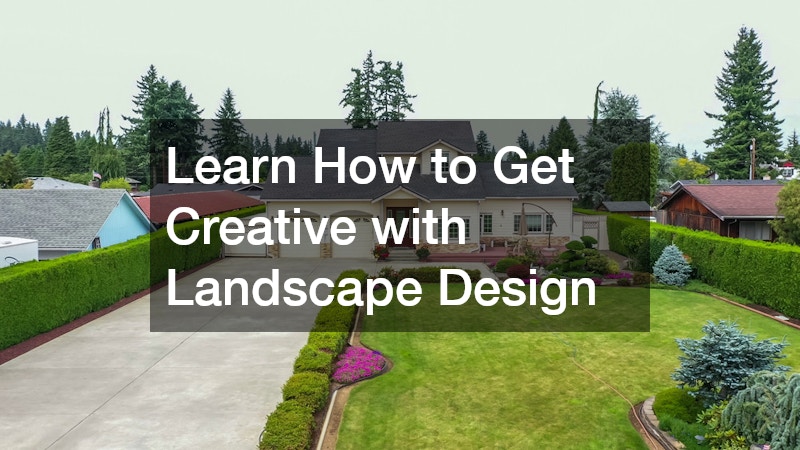Landscape design is an art form that requires both creativity and technical knowledge. It’s not just about planting flowers or placing shrubs; it’s about creating a living, breathing environment that reflects your unique vision. In this article, we will explore how you can bring creativity into your landscape design, transforming your outdoor space into a beautiful sanctuary.
How to Start Planning a Landscape Design
A successful landscape design starts with clearly defined goals. Understanding what you want to achieve can streamline your project and ensure the outcome aligns with your vision.
Additionally, establishing a realistic budget from the outset is crucial to maintaining financial control without stifling your creativity.
When you have clear goals, you prevent unnecessary spending and keep the project focused. It is important to prioritize which elements are most important to you so that they can be accommodated financially. Keep in mind that a well-planned budget allows room for unexpected challenges or design inspiration that may arise during the process.
Analyzing your landscape space is a vital step in developing an effective landscape design. Start by evaluating your climate, soil type, and existing plant life to identify what will thrive in your environment. Understanding these factors enables you to make informed decisions that align well with the natural characteristics of your site.
Knowing your site’s sun and shade patterns can inform your choice of plant placement and material selection. This environmental analysis can also help avoid costly mistakes later in the process. By working with the natural features of your space, you minimize ongoing maintenance requirements and create a more sustainable design.
Incorporating Personal Style
Your landscape is an extension of your home and should mirror your personal style. Whether you prefer a minimalist aesthetic or a lush, vibrant garden, the key is to select design elements that inspire you. Begin by identifying features that resonate with you and consider how they can be integrated harmoniously into your existing space.
Use your landscape to express creativity through unique furnishings, custom-built structures, or distinctive plant selections. Think about how you want people to feel when they explore your garden. Personal touches can transform ordinary spaces into extraordinary expressions of individuality.
What Are the Key Elements of Creative Landscape Design?
Utilizing Color Schemes
Color plays a pivotal role in landscape design, affecting the overall mood and perception of space. By understanding color theory, you can decide whether to use harmonious palettes or contrasting hues to create desired effects. The smart use of color can draw attention to focal points and add dynamic interest to different areas.
Seasonal color changes offer opportunities to refresh the look of your landscape regularly. Including a mix of perennials, annuals, and shrubs ensures year-round color variation and texture. Bold colors may energize the space, while softer tones often provide calming elements.
Textural Balance
Texture in landscape design is often underrated, but it significantly contributes to the tactile and visual satisfaction of the area. Mixing different textures creates contrast and interest, preventing stark and monotonous landscapes from dominating your space. Incorporate elements like coarse bark, smooth leaves, and polished stones to achieve textural diversity.
The use of texture also influences the perception of space, size, and dimension. Rough textures tend to make plants and structures feel closer, while fine textures can make areas seem larger or more open. Combining textures harmoniously creates depth and layers within your garden.
The Importance of Shape and Form
Shape and form are essential components in landscape design, serving both functional and aesthetic purposes. Geometric lines can create formal styles, whereas organic shapes lend themselves to more relaxed settings. The balance of these forms directly impacts the overall flow and utility of the outdoor space.
Different forms can create focal points, guide movement, and dictate the spatial organization of your garden. Combining curves, squares, and circles adds dynamic interest and offers various levels of engagement with the landscape. Diverse forms also facilitate the balance between hardscape and softscape elements.
How to Maintain a Newly Designed Landscape
Implementing a Sustainable Maintenance Plan
For a thriving landscape, developing a sustainable maintenance plan is essential. This plan should include environmentally friendly practices that align with the specific needs of your plants and materials. Routine inspections and adjustments streamline the maintenance process, ensuring the landscape’s longevity.
Consider investing in smart irrigation systems and using organic fertilizers to reduce water waste and improve plant health. Creating a layout that accommodates easy maintenance will incentivize regular care and management. Sustainability not only preserves the environment but also protects your investment for years to come.
Seasonal Care Tips
Landscape care varies with each changing season, so it’s crucial to tailor your efforts accordingly. In the spring, focus on cleaning debris and preparing the soil for new growth, ensuring a vibrant start to the season. During summer, addressing drought-related stress through consistent watering will nurture continual growth.
Come autumn, implementing measures like mulching helps retain moisture and protect root systems as temperatures drop. Winter care involves protecting plants from frost and ensuring landscape structures withstand severe weather. Each season presents unique challenges that require specific actions for optimal care.
By adapting your maintenance techniques to each season, you maintain the beauty and vigor of your landscape design. Seasonal preparation not only supports plant health but also simplifies care throughout the year. These proactive efforts make it easier to address issues before they escalate, ensuring consistent upkeep.
Through careful planning and creative expression, you can transform your outdoor space into an enviable landscape. By understanding key elements such as color, texture, and shape, you enhance both the aesthetic and functional aspects of your design. Armed with maintenance strategies and creative problem-solving, your landscape can continue to thrive, inspiring both joy and wonder.

